Screen types and types of fabric
There is an almost vast number of different screens with different radiation patterns in the market. Even though for most of the buyers, only one certain type of screen comes into question, this page is supposed to contribute to the clarification and comprehension of the different types of screens and their characteristic features.
In the German Industry Standard DIN 19045-4 titled "Projection of moving and still images", in the 4th part subtiled "Reflection- and transmission properties of screens; indentity sizes, type of screen, measurement", there are some screens subdivided into four main groups according to their respective properties of reflection and transmission. The so-called light density factor (or luminance factor) that is also called gain-factor serves as a basis for the evaluation of the properties of reflection and transmission of a screen. In our website about Light density factors there is some detailled information.
From this page about the light density factor we have learned that the gain factor indicates how a piece of screen radiates in comparison to a piece of a standard screen. Anyway, we learned that the gain-factor is only applied for a very certain emission direction.
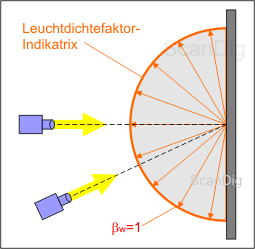
In order to describe all refection properties of a screen, we need the luminance factor for the different emission directions, thus practically a table in which a light density factor is assigned to each of the different viewing angles. In order to visualize such a table, we have been introduced to a diagram named light density factor-indicatrix. The adjacent graph demonstrates such a distribution for an optimal white wall, the way it is very hard to achieve in practice. This optimal white surface diffuses the incidenting light uniformly to all directions, no matter of the angle with which the light incidents on the surface. We can recognize the uniform light-emitting into all directions by looking at the semicircle that spans around the point of the incidenting light. This diagram serves as a reference for understanding the screen types presented in the following chapters. We will repeatedely make a comparison of the diagram of the respective screen with this white surface-reference and clarify therewith the reflection properties of the respective type of screen.
But an important question should be previously answered that is why there are so many different screens at all. We have already seen on the website about the Light density factor that the light and audience conditions of a narrow training room are completely different of those in a living room. While in the living room, the reflected light is supposed to be emitted into almost all directions, such a radiation pattern in a narrow training room would cause that a major part of the available light would get lost. There are similar results when the projector is hanging from the ceiling and standing on the floor. In the following text we will talk about the typical application cases of each of the types of screen.
Screen type D
We start with the most simple type of screens that is D. A screen with the screen type D diffuses the incidenting light mainly uniformly into all directions and does not feature any pronounced preferential direction of the reflection. The screen perpendicular is a slightly preferential direction; it is plausible that a little more light is reflected to this direction than in the case of a right angle. Thus, it can be said that such a screen reflects the incidenting light in an almost uniform way, and the screen type D is derived from the term diffuse.
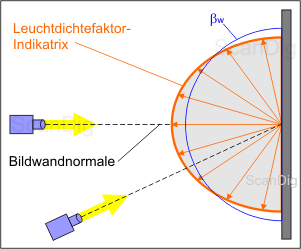
In case of a screen type D, the direction from which the light incidents almost does not play any role; the reflecting properties are almost constant. The adjoining figure illustrates this. In this illustration, the blue semicircle exactly corresponds to the luminance indicatrix that we have seen in the previous chapter as an optimal white reflection surface. While such an optimal white surface diffuses the incidenting light uniformly into all directions, our screen of type D reflects a little more into the direction of the perpendicular, and a little less in direction of the vertical. But we are still almost at the reflection perpendicular of the previous chapter.
Such a screen is also named a Diffuse screen. Such a screen is for example a normal screen made of canvas or smooth plastic. But also a smooth and plain wall surface painted with white and matt finished wall paint also has those reflection properties. The screen walls of type D are normally described with a gain factor between 1,1 and 1,3. This amplification factor corresponds to the slightly amplified reflection in direction to the screen perpendicular. From the knowledge of the correspondent image it is then possible to conclude that in a direction between 40 and 60 degrees a gain-factor of 1 prevails that up to an angle of 90°, decreases to slightly under 1.
The screen of the type D are optimal for the use in the living room, where most of the times, the projector is mounted at the height of the screen wall (or slightly above it) and where the couch or the cinema armchair is underneath it. By this way, the viewer who sits on the executive chair gets a little more light (gain factor 1,2), but the image is still very well recognizable from the rest of the room, as for example from the dining table.
Screen type B
Some readers might already have continued clicking after having read in the previous chapter that the right type of screen for the use in the living room is type D. Anyway, we continue now with the next screen of the type B. The screen D that was described in the previous chapter outstands due to the reason that it does not have a preferential direction of reflection. This is different in the case of the screen type B: all the screens of type B present a preferential direction that concurs with the incidenting light.
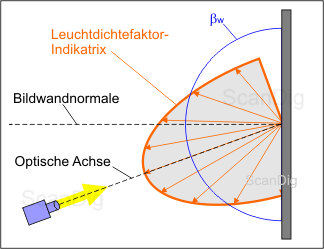
The best to understand what this means is to look at the adjacent illustration. Our light source radiates on the screen in an inclined angle. This is for example the case when our beamer stands on a small table or on the floor, but the screen hangs on the wall at a certain height. Again, we recognize the blue semicircle that marks the reflecting properties of an optimal, matt-white and perfectly reflecting and diffusing screen. Our red coloured light density factor-indicatrix strongly differs from the shape of the semicircle; additionally, it is turned by an angle around the screen perpendicular. Its maximum points exactly in direction to the optical axis, thus those axis from which direction the light of the projector falls on the light panel. The maximum of the light density factor - indicatrix clearly outstands from the blue standard circle; from that, we conclude a gain-factor of approximately 1,5 up to 1,7. To the contrary, at the edges of the indicatrix there is a light density factor of barely 0,5 up to 0,7.
Thus, a screen of the type B reflects the incidenting light back in the same angle it falls on the screen. In order to obtain such reflecting properties, the nomal screens of fabrics or plastic are not sufficient. The projection screens of type B certainly also have a base of canvas or plastic as a substrate, but there are some tiny glass balls fixed on it that provide the special reflection property. Due to this reason, those screens are also called pearl screens or crystal screens.
Where are those special screens applied? Those who think that they also need such a screen for their living room because the projector usually stands on the floor or hangs from the ceiling, are wrong. The angular relationships are still small; moreover, the light is supposed to be diffused within the whole living room, as usual. The screens of type B are mainly applied in big lecture halls or auditoriums, thus generally in very high and deep rooms where the avaible light quantity of the projector has to be carefully calculated.
Screen type S
The screen type B presented in the previous chapter was not very easy to imagine; finally, it is against all experience of life that some light falls on a surface in an inclined angle and is reflected by the same angle. One can imagine a billard table on which one hits a ball in an inclined angle and it comes back in the same inclined angle...
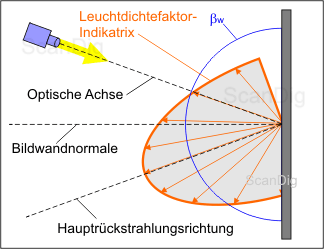
Now we get to the screen type S that works as a billard ball or as a normal mirror. The adjoining figure exactly clarifies this behaviour: the light that falls in an inclined angle on the screen is mirrored at the screen perpendicular and reflected with an angle of incidence that is exactly equal to the angle of reflection. The direction of the incidenting light is named optical axis, the direction of the reflected light as the main beam direction. Both axis have the same angle to the screen perpendicular. As it was the case in the previous chapter, with the light density factor-indicatrix we recognize that the light is bundled in the main beam direction; we read a gain-factor from 1,5 to 1,7. But at the edges, we only see a gain factor of about 0,5 up to 0,7.
A screen of type S also needs a very special surface in order to achieve this behaviour of reflection. On a substrate layer made of fabric or plastic, a thin film of metal or silver particles that are eventually additionally structured in a shape of grooves or lenses. In order to protect it against oxidation and other chemical influences, there is a additional translucent protective layer. This is why such screens are also called Metal screens or Silver screens.
The application of screens of type S is obvious: if there is a projector hanging at the ceiling of a high room,the screen at a medium height and the audience on the floor, we have represented the same angular relationships as in the picture above. But also in this case, I do not mean the living room heighted 2,50 m, but lecture halls, where the light quantity available has to be handled with care.
Screen type R
I am going to mention the fourth and last type of screen only for the sake of completeness. It is about the screen for the Rear projection, this is why the type description is R. Such a screen surely not stands in the living room of a private person. Such a screen is beamed from the back with an horizontally reflected image. The light is not reflected but transmitted.
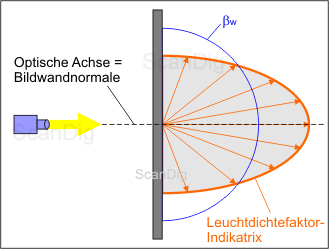
Let us have a look at the adjoining picture in order to understand the behaviour of such a screen. The light source beams at the screen vertically from the back; thus, the optical axis is located in the screen perpendicular. In contrast to the screens we talked about in the previous chapters, the incidenting light is not reflected back to a certain direction but it goes through the screen (transmission). In the image we recognize a preferential direction to the screen perpendicular. By comparing the red actual light density factor-indicatrix with the blue semicircle (optimally 100% reflecting and diffusing screen) we read a gain factor of about 1,5. Thus, we are talking about a preferential direction for the transmission (not for the reflection).
The screens of type R consists on very special materials and surfaces in order to maintain the desired behaviour of transmission. On a substrate that most of the times is bright, there are some special layers arranged that are structured and partly unstructured.
As already mentioned in the beginning, the screens of type R will surely not be found in the living room of a home. But those who have already looked at a screen in the theatre or in a trade fair and could not see any light source will know now that this must have been a rear projection screen in which the projector is hidden behind the screen.
Back to the index projection screens
|